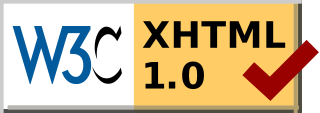A document type definition (DTD) is a specification file that contains set of markup declarations that define a document type for an SGML-family markup language. The DTD specification file can be used to validate documents.
SVG is an XML-based vector image format for defining two-dimensional graphics, having support for interactivity and animation. The SVG specification is an open standard developed by the World Wide Web Consortium since 1999.

Synchronized Multimedia Integration Language ) is a World Wide Web Consortium recommended Extensible Markup Language (XML) markup language to describe multimedia presentations. It defines markup for timing, layout, animations, visual transitions, and media embedding, among other things. SMIL allows presenting media items such as text, images, video, audio, links to other SMIL presentations, and files from multiple web servers. SMIL markup is written in XML, and has similarities to HTML.
Mathematical Markup Language (MathML) is a mathematical markup language, an application of XML for describing mathematical notations and capturing both its structure and content, and is one of a number of mathematical markup languages. Its aim is to natively integrate mathematical formulae into World Wide Web pages and other documents. It is part of HTML5 and standardised by ISO/IEC since 2015.
X3D is a set of royalty-free ISO/IEC standards for declaratively representing 3D computer graphics. X3D includes multiple graphics file formats, programming-language API definitions, and run-time specifications for both delivery and integration of interactive network-capable 3D data. X3D version 4.0 has been approved by Web3D Consortium, and is under final review by ISO/IEC as a revised International Standard (IS).
XHTML Basic is an XML-based structured markup language primarily designed for simple user agents, often found in mobile devices such as mobile phones, PDAs, pagers, and set-top boxes..
XML Linking Language, or XLink, is an XML markup language and W3C specification that provides methods for creating internal and external links within XML documents, and associating metadata with those links.

The Markup Validation Service is a validator by the World Wide Web Consortium (W3C) that allows Internet users to check pre-HTML5 HTML and XHTML documents for well-formed markup against a document type definition. Markup validation is an important step towards ensuring the technical quality of web pages. However, it is not a complete measure of web standards conformance. Though W3C validation is important for browser compatibility and site usability, it has not been confirmed what effect it has on search engine optimization.
Speech Recognition Grammar Specification (SRGS) is a W3C standard for how speech recognition grammars are specified. A speech recognition grammar is a set of word patterns, and tells a speech recognition system what to expect a human to say. For instance, if you call an auto-attendant application, it will prompt you for the name of a person. It will then start up a speech recognizer, giving it a speech recognition grammar. This grammar contains the names of the people in the auto attendant's directory and a collection of sentence patterns that are the typical responses from callers to the prompt.
In computing, quirks mode is an approach used by web browsers to maintain backward compatibility with web pages designed for old web browsers, instead of strictly complying with web standards in standards mode. This behavior has since been codified, so what was previously standards mode is now referred to as simply no quirks mode.
In computer science and web development, XML Events is a W3C standard for handling events that occur in an XML document. These events are typically caused by users interacting with the web page using a device, such as a web browser on a personal computer or mobile phone.
Semantic Interpretation for Speech Recognition (SISR) defines the syntax and semantics of annotations to grammar rules in the Speech Recognition Grammar Specification (SRGS). Since 5 April 2007, it is a World Wide Web Consortium recommendation.
XML documents typically refer to external entities, for example the public and/or system ID for the Document Type Definition. These external relationships are expressed using URIs, typically as URLs.
Extensible HyperText Markup Language (XHTML) is part of the family of XML markup languages which mirrors or extends versions of the widely used HyperText Markup Language (HTML), the language in which Web pages are formulated.
In computing, Facelets is an open-source Web template system under the Apache license and the default view handler technology for Jakarta Server Faces. The language requires valid input XML documents to work. Facelets supports all of the JSF UI components and focuses completely on building the JSF component tree, reflecting the view for a JSF application.

EPUB is an e-book file format that uses the ".epub" file extension. The term is short for electronic publication and is sometimes styled ePub. EPUB is supported by many e-readers, and compatible software is available for most smartphones, tablets, and computers. EPUB is a technical standard published by the International Digital Publishing Forum (IDPF). It became an official standard of the IDPF in September 2007, superseding the older Open eBook (OEB) standard.
XHTML+RDFa is an extended version of the XHTML markup language for supporting RDF through a collection of attributes and processing rules in the form of well-formed XML documents. XHTML+RDFa is one of the techniques used to develop Semantic Web content by embedding rich semantic markup. Version 1.1 of the language is a superset of XHTML 1.1, integrating the attributes according to RDFa Core 1.1. In other words, it is an RDFa support through XHTML Modularization.
The Web platform is a collection of technologies developed as open standards by the World Wide Web Consortium and other standardization bodies such as the Web Hypertext Application Technology Working Group, the Unicode Consortium, the Internet Engineering Task Force, and Ecma International. It is the umbrella term introduced by the World Wide Web Consortium, and in 2011 it was defined as "a platform for innovation, consolidation and cost efficiencies" by W3C CEO Jeff Jaffe. Being built on The evergreen Web has allowed for the addition of new capabilities while addressing security and privacy risks. Additionally, developers are enabled to build interoperable content on a cohesive platform.
Multimodal Architecture and Interfaces is an open standard developed by the World Wide Web Consortium since 2005. It was published as a Recommendation of the W3C on October 25, 2012. The document is a technical report specifying a multimodal system architecture and its generic interfaces to facilitate integration and multimodal interaction management in a computer system. It has been developed by the W3C's Multimodal Interaction Working Group.
A document type declaration, or DOCTYPE, is an instruction that associates a particular XML or SGML document with a document type definition (DTD). In the serialized form of the document, it manifests as a short string of markup that conforms to a particular syntax.









